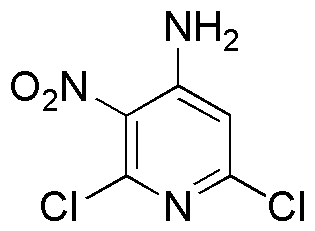4-Amino-2,6-dichloro-3-nitropyridine is widely utilized in research focused on:
- Agricultural Chemicals: This compound is often used in the development of herbicides and pesticides, providing effective solutions for crop protection against weeds and pests.
- Pharmaceuticals: It serves as an intermediate in the synthesis of various pharmaceutical agents, contributing to the creation of medications that target specific diseases.
- Dyes and Pigments: The chemical is employed in the production of dyes, particularly in the textile industry, where it helps create vibrant colors that are resistant to fading.
- Its unique properties make it valuable in the formulation of advanced materials, including polymers that require enhanced durability and chemical resistance.
- Research and Development: Scientists utilize this compound in various research applications, including studies on chemical reactivity and the development of new synthetic pathways.
General Information
Properties
Safety and Regulations
Applications
4-Amino-2,6-dichloro-3-nitropyridine is widely utilized in research focused on:
- Agricultural Chemicals: This compound is often used in the development of herbicides and pesticides, providing effective solutions for crop protection against weeds and pests.
- Pharmaceuticals: It serves as an intermediate in the synthesis of various pharmaceutical agents, contributing to the creation of medications that target specific diseases.
- Dyes and Pigments: The chemical is employed in the production of dyes, particularly in the textile industry, where it helps create vibrant colors that are resistant to fading.
- Its unique properties make it valuable in the formulation of advanced materials, including polymers that require enhanced durability and chemical resistance.
- Research and Development: Scientists utilize this compound in various research applications, including studies on chemical reactivity and the development of new synthetic pathways.
Documents
Safety Data Sheets (SDS)
The SDS provides comprehensive safety information on handling, storage, and disposal of the product.
Product Specification (PS)
The PS provides a comprehensive breakdown of the product’s properties, including chemical composition, physical state, purity, and storage requirements. It also details acceptable quality ranges and the product's intended applications.
Certificates of Analysis (COA)
Search for Certificates of Analysis (COA) by entering the products Lot Number. Lot and Batch Numbers can be found on a product’s label following the words ‘Lot’ or ‘Batch’.
*Catalog Number
*Lot Number
Certificates Of Origin (COO)
This COO confirms the country where the product was manufactured, and also details the materials and components used in it and whether it is derived from natural, synthetic, or other specific sources. This certificate may be required for customs, trade, and regulatory compliance.
*Catalog Number
*Lot Number
Safety Data Sheets (SDS)
The SDS provides comprehensive safety information on handling, storage, and disposal of the product.
DownloadProduct Specification (PS)
The PS provides a comprehensive breakdown of the product’s properties, including chemical composition, physical state, purity, and storage requirements. It also details acceptable quality ranges and the product's intended applications.
DownloadCertificates of Analysis (COA)
Search for Certificates of Analysis (COA) by entering the products Lot Number. Lot and Batch Numbers can be found on a product’s label following the words ‘Lot’ or ‘Batch’.
*Catalog Number
*Lot Number
Certificates Of Origin (COO)
This COO confirms the country where the product was manufactured, and also details the materials and components used in it and whether it is derived from natural, synthetic, or other specific sources. This certificate may be required for customs, trade, and regulatory compliance.


